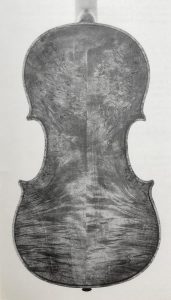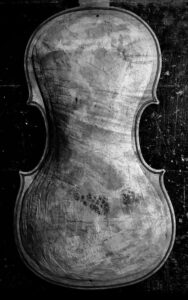In the early winter of 1992 I attended an auction of Sothebys at the Palazzo Broggi in Milan with the aim of finding “sleeper” violins; hence those whose true value have been somehow overlooked by the managers and consultants appraising the instruments. Having long been a part of the violin hunter culture in Wien, my method of paying my bread, butter and beer by sleuthing out old fiddles was a very viable one during apprenticeship with Anton Sobezack in Poland and Gasparo Karoly in Austria.
In Vienna, combing through the antique markets at 5am with a flashlight , I had found occasionally and always by pure chance, somewhat valuable fiddles, and as I had little time for new making, their sales helped me get through the early years of learning my craft. These were the wild years of dealing instruments!
Most makers dabble in dealing old violins on some level or another. Many end up in a kind of trap or endless cycle of bow repairs, and selling antiques to get by. It is just a fact of life. Pursuing the catalog on the train while watching the bleak snowy landscape of Lower Austria in darkness, I was suddenly struck by this image of a beautiful maple back in the feeble overhead light of the train. . The violin was cataloged as School of Ventepane, with a ridiculously low starting price of 20,000Iira. The flames chaotic in the lower bouts, with curious root markings spattered all around the edges. The curious wood choice of root-marked maple was certainly not incongruent with woods often used by Neapolitan makers. The root markings to me were just stunning, creating a kind of wild texture and blotted areas of speckled darkness, as if a lonely moon struck by debris, asteroids, eternally scarred!

With eyes closed in the sleeper compartment of the train, I dreamt the very old, but common fantasy of every violin dealer throughout history; to purchase a fine, expensive instrument for little money.
Wishful thinking! Measured over the arching the corpus was quite large at 36.5cm, with inlaid, not painted purfling. The instrument appears to have been made without a mould, as the corners and center bouts are rather asymmetrical.
Fortunately now I no longer have to comb the antique markets in Vienna to find substanance. I am purely focused on new making. But the seed of that beautiful Neapolitan fiddle remained buried in my mind, dormant, until finally in 2012, over ten years later when I came across a stunning piece of maple in the stock of the greatest European wood seller, Reinhard Zach. Here were the root markings, and the chaotic moonscape I had seen in 1992!
 It would be an additional 10 years before I finally got to that particular piece of maple.
It would be an additional 10 years before I finally got to that particular piece of maple.
Looking through the old dusty catalog while working on this current violin, I remembered many the train journey so many years ago, and coupled with the nostalgia for the “wild years” of dealing and learning my craft, I finally decided to make the Ventepane.
One rarely encounters a newly made violin with corpus dimensions this large, and if one does, its probably the “Long Pattern Stradivari “
I began to revisit the hundreds of Sothebys and other auction catalogs moulding and gathering dust in the workshop. On this particular day in Milan, out of 32 violins for sale, 12 were over 36cm corpus!
And yet, when you walk into a violin shop right now, in 2023, and ask for a violin larger than 36cm, they will probably scratch their heads, or, perhaps have a single antique or so laying around. New makers tend to shy from making larger violins, due to the stop length issue, which after is is logically grounded in modern violin performance, and tattooed on the inner eyelids of every maker who passes through lutherie school. 19.5 is the Mensur!
Here however, below, a short list of makers whom dabbled with the mighty giant fiddle! You may have heard of some of them!
Late 15th-16thc: Brescia, Gasparo Da Salo, Paolo Maggini
ca.1670-80: Brescia, Rogeri
1690’s: Cremona, Stradivari
1710-20: London, Daniel Parker
1710-20: Goffriller
1700 onwards: Paris: Pierray, Boquay.
1750’s onwards, Livorno, Gragnani
1780’s Cremona, Nicolo and Carlo II Bergonzi
And let us not forget Ventapane! So is there something we are missing, old friend?
